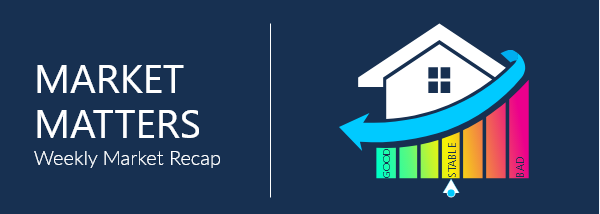Market Matters

This was a very volatile week in the Treasury and MBS market. The 10-year traded up to nearly 3.50% prior to the Fed meeting, and then rallied after the Fed raised rates 75 basis points and indicated that in July, they will most likely raise rates 50 or 75 basis points. This is in response to persistently high inflation that is impacting the economy. Until inflation is reigned in, or the economy seriously slows, and unemployment becomes a problem, we will likely have a very hawkish Fed on our hands. Best to be defensive and careful here.
 Initial Jobless Claims
Initial Jobless Claims
Initial Jobless Claims fell -3k to 229k for the week ended June 11th from a revised 232k in the prior week (229k orig.). The 4-week moving average rose from 215.8k to 218.5k, now the highest since the end of January. Continuing claims, which lag a week, rose to 1.312mln from a revised level of 1.309mln (1.306 orig.). The number of claimants in all programs hardly changed in the week ended May 28th, down from 1.284mln to 1.282mln.
 Housing Starts
Housing Starts
Residential construction for May saw building permits drop -7.0% to 1.694mln, while housing starts dropped by -14.4% to 1.549mln. Both numbers were significantly lower than market expectations for 1.785mln and 1.701mln, respectively. Although permits saw a large decline, they are still +.2% higher vs. May 2021. Single-family permits were at 1.048mln in May, which is -5.5% below last month. Regionally, all have declined with the largest drop in the Northeast at -20.2%, with all others dropping less than 10%. Looking at housing starts, we see a -3.5% YoY drop for May, and now posting their weakest levels since February 2021. Single-family starts dropped -9.2% from April and are also -5.3% weaker vs. the May 2021 level. The Northeast and Midwest had decent gains, +14.6% and +1.9%, while the South fell -20.7% and the West down -17.8%.
 Retail Sales
Retail Sales
Retail Sales for May fell -.3% vs. expectations of an increase of +.2% for the month. Ex-autos, sales were up +.5%, while the core control group was flat with no growth. April numbers were also revised lower, with the headline down -.2% to +.7%, ex-autos down -.2% to +.4%, and control down -.5% to +.5%. Despite a notable price-driven gain in gas station receipts (+4.0%, $2.534bln) and modest gains in food service/drinking places (+.7%, $566mln) and building materials (+.2%, $94mln), a big drop in auto sales (-3.5%, $4.610bln) pulled the headline into negative territory. The only other significant drop was seen by non-store retailers (-1.0%, $1.022bln), with smaller ones in miscellaneous stores (-1.1%, $168mln), furniture (-.9%, $110mln), electronics/appliances (-1.3%, $104mln), and health/personal care (-0.2%, $80mln). The only significant positive contributor was food/beverage stores (+1.2%, $948mln), with insignificant gains in general merchandise (+.1%, $76mln), sporting goods/hobby (+.4%, $38mln), and clothing/accessories (+.1%, $38mln).
 Producer Price Index
Producer Price Index
Producer Price Index which is a measure of the priced paid to producers of goods and services, rose +.8% in May, and was up +10.8% YoY. Both numbers this morning were right in-line with market expectations. Stripping out food and energy, the core PPI rose +.5% on the month, and was up +6.8% on a YoY basis. Both measures of headline and core inflation on the wholesale level are near historic highs that we saw back in March of +11.5% and +7.1%, respectively. Overall, for wholesale prices, the energy sector made up much of the gains in May. The index for final demand energy was up +5.0% on the month. Within the energy numbers, gasoline rose +8.4%. On the services side, transportation and warehousing were contributors for more than half the gain of +.4%.

